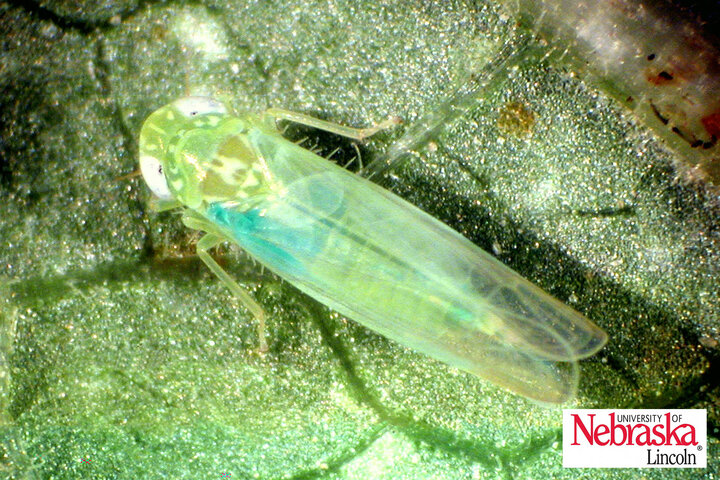Potato leafhoppers are starting to injure alfalfa in many areas. Scouting for these insects and protecting your alfalfa from injury may be needed in your fields.

An early symptom of leafhopper damage is a triangular or V-shaped yellow or purple area at the tip of alfalfa leaves. This discoloration is caused by a toxin the leafhopper injects into the alfalfa plant as it sucks out plant juices. As feeding continues, the entire plant can turn yellow and growth may stop.
Check fields at least weekly for leafhoppers before symptoms appear. Don't wait! If you detect leafhoppers early and they are present at threshold levels, insecticides can kill them easily. Continue to scout for leafhoppers after treatment since leafhoppers can migrate from other fields and reinfect your sprayed field.However, if your alfalfa already is yellow and stunted, do not spray. Instead, first mow your alfalfa to remove affected plant tissue and to stimulate new growth. Unmown plants might not grow much more all year, lowering yield and potentially leading to stand loss over winter.
After mowing fields, scout new regrowth at least weekly for leafhoppers. If they reappear, then use insecticides if threshold levels are present.
Treatment Thresholds and Insecticides
Treatment decisions are based on numbers captured by a sweep net. (A sweep net is the only reliable way to scout for potato leafhoppers.) See Tables 1-3 for decision-making help. Note that there do not have to be many to cause a problem.
Many insecticides are registered for control, and all will provide good results when applied properly. Commonly used insecticides include Mustang, Warrior, Baythroid, and Lorsban or products with the same active ingredients.
For a list of registered alfalfa insecticides, see the Insecticide Section of the UNL Extension EC130, Guide for Weed Management with Insecticide and Fungicide Information. (Updated: Also see Alfalfa Insecticides, 2016.)
Bruce Anderson
Extension Forage Specialist
Bob Wright
Extension Entomologist
| Table 1. Dynamic treatment thresholds for potato leafhoppers (average number per sweep) on alfalfa that is 1 to 4 inches tall. | ||||||
|
Value of hay (per ton) |
Cost of insecticide application (per acre) |
|||||
|
|
$8 |
$10 |
$12 |
$14 |
$16 |
$20 |
|
$ 60 |
0.4 |
0.5 |
0.6 |
0.7 |
0.8 |
1.0 |
|
$ 80 |
0.3 |
0.4 |
0.5 |
0.5 |
0.6 |
0.75 |
|
$100 |
0.25 |
0.3 |
0.4 |
0.4 |
0.5 |
0.6 |
|
$120 |
0.2 |
0.25 |
0.3 |
0.35 |
0.4 |
0.5 |
|
$140 |
0.2 |
0.2 |
0.25 |
0.3 |
0.3 |
0.4 |
|
$160 |
0.15 |
0.2 |
0.3 |
0.3 |
0.3 |
0.4 |
| Table 2. Dynamic treatment thresholds for potato leafhoppers (average number per sweep) on alfalfa that is 4 to 8 inches tall.
|
||||||
|
Value of hay (per ton) |
Cost of insecticide application (per acre) |
|||||
|
|
$8 |
$10 |
$12 |
$14 |
$16 |
$20 |
|
$ 60 |
0.7 |
0.8 |
1.0 |
1.0 |
1.3 |
1.7 |
|
$ 80 |
0.6 |
0.6 |
0.75 |
0.9 |
1.0 |
1.3 |
|
$100 |
0.4 |
0.5 |
0.6 |
0.7 |
0.8 |
1.0 |
|
$120 |
0.3 |
0.4 |
0.5 |
0.6 |
0.7 |
0.8 |
|
$140 |
0.3 |
0.35 |
0.4 |
0.5 |
0.6 |
0.7 |
|
$160 |
0.25 |
0.3 |
0.4 |
0.4 |
0.5 |
0.6 |
|
Table 3. Dynamic treatment thresholds for potato leafhoppers (average number per sweep) on alfalfa that is 8 to 12 inches tall. |
||||||
|
Value of hay (per ton) |
Cost of insecticide application (per acre) |
|||||
|
|
$8 |
$10 |
$12 |
$14 |
$16 |
$20 |
|
$ 60 |
2.0 |
2.4 |
2.8 |
3.0 |
3.9 |
5.0 |
|
$ 80 |
1.8 |
1.9 |
2.2 |
2.7 |
3.0 |
4.0 |
|
$100 |
1.2 |
1.5 |
1.8 |
2.1 |
2.4 |
3.0 |
|
$120 |
0.9 |
1.2 |
1.5 |
1.8 |
2.1 |
2.4 |
|
$140 |
0.9 |
1.0 |
1.2 |
1.5 |
1.8 |
2.0 |
|
$160 |
0.8 |
0.9 |
1.0 |
1.2 |
1.5 |
1.8 |
